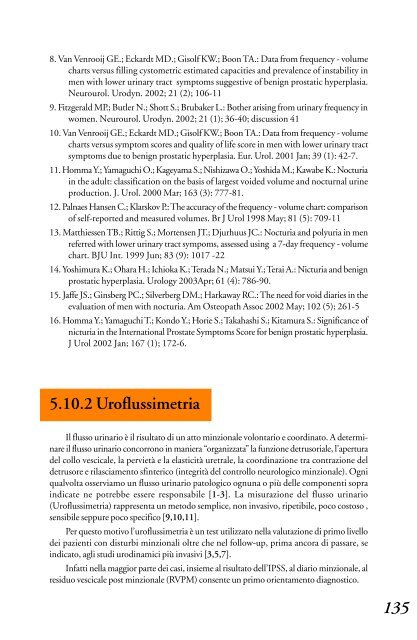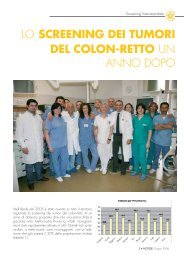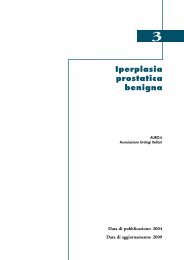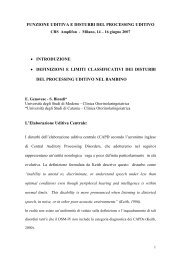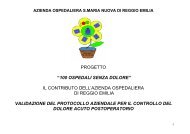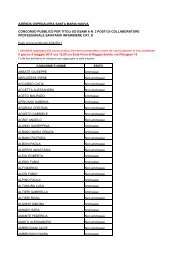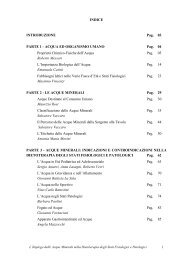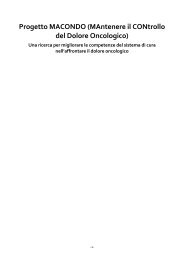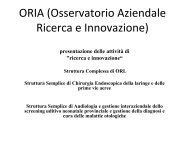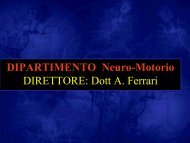4.3.1 Sintesi e raccomandazioni - Biblioteca Medica
4.3.1 Sintesi e raccomandazioni - Biblioteca Medica
4.3.1 Sintesi e raccomandazioni - Biblioteca Medica
You also want an ePaper? Increase the reach of your titles
YUMPU automatically turns print PDFs into web optimized ePapers that Google loves.
8. Van Venrooij GE.; Eckardt MD.; Gisolf KW.; Boon TA.: Data from frequency - volume<br />
charts versus filling cystometric estimated capacities and prevalence of instability in<br />
men with lower urinary tract symptoms suggestive of benign prostatic hyperplasia.<br />
Neurourol. Urodyn. 2002; 21 (2); 106-11<br />
9. Fitzgerald MP.; Butler N.; Shott S.; Brubaker L.: Bother arising from urinary frequency in<br />
women. Neurourol. Urodyn. 2002; 21 (1); 36-40; discussion 41<br />
10. Van Venrooij GE.; Eckardt MD.; Gisolf KW.; Boon TA.: Data from frequency - volume<br />
charts versus symptom scores and quality of life score in men with lower urinary tract<br />
symptoms due to benign prostatic hyperplasia. Eur. Urol. 2001 Jan; 39 (1): 42-7.<br />
11. Homma Y.; Yamaguchi O.; Kageyama S.; Nishizawa O.; Yoshida M.; Kawabe K.: Nocturia<br />
in the adult: classification on the basis of largest voided volume and nocturnal urine<br />
production. J. Urol. 2000 Mar; 163 (3): 777-81.<br />
12. Palnaes Hansen C.; Klarskov P.: The accuracy of the frequency - volume chart: comparison<br />
of self-reported and measured volumes. Br J Urol 1998 May; 81 (5): 709-11<br />
13. Matthiessen TB.; Rittig S.; Mortensen JT.; Djurhuus JC.: Nocturia and polyuria in men<br />
referred with lower urinary tract sympoms, assessed using a 7-day frequency - volume<br />
chart. BJU Int. 1999 Jun; 83 (9): 1017 -22<br />
14. Yoshimura K.; Ohara H.; Ichioka K.; Terada N.; Matsui Y.; Terai A.: Nicturia and benign<br />
prostatic hyperplasia. Urology 2003Apr; 61 (4): 786-90.<br />
15. Jaffe JS.; Ginsberg PC.; Silverberg DM.; Harkaway RC.: The need for void diaries in the<br />
evaluation of men with nocturia. Am Osteopath Assoc 2002 May; 102 (5); 261-5<br />
16. Homma Y.; Yamaguchi T.; Kondo Y.; Horie S.; Takahashi S.; Kitamura S.: Significance of<br />
nicturia in the International Prostate Symptoms Score for benign prostatic hyperplasia.<br />
J Urol 2002 Jan; 167 (1); 172-6.<br />
5.10.2 Uroflussimetria<br />
Il flusso urinario è il risultato di un atto minzionale volontario e coordinato. A determinare<br />
il flusso urinario concorrono in maniera “organizzata” la funzione detrusoriale, l’apertura<br />
del collo vescicale, la pervietà e la elasticità uretrale, la coordinazione tra contrazione del<br />
detrusore e rilasciamento sfinterico (integrità del controllo neurologico minzionale). Ogni<br />
qualvolta osserviamo un flusso urinario patologico ognuna o più delle componenti sopra<br />
indicate ne potrebbe essere responsabile [1-3]. La misurazione del flusso urinario<br />
(Uroflussimetria) rappresenta un metodo semplice, non invasivo, ripetibile, poco costoso ,<br />
sensibile seppure poco specifico [9,10,11].<br />
Per questo motivo l’uroflussimetria è un test utilizzato nella valutazione di primo livello<br />
dei pazienti con disturbi minzionali oltre che nel follow-up, prima ancora di passare, se<br />
indicato, agli studi urodinamici più invasivi [3,5,7].<br />
Infatti nella maggior parte dei casi, insieme al risultato dell’IPSS, al diario minzionale, al<br />
residuo vescicale post minzionale (RVPM) consente un primo orientamento diagnostico.<br />
135


